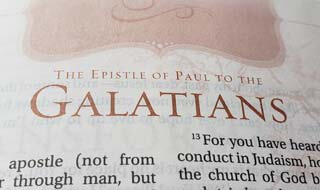Imagine that a hero was needed to save us from death, and that he had to come from the far edge of the Milky Way galaxy to do it. The trip of 70,000 light years would be hard to fathom. But if he arrived and then laid down his life to save us, what a wonderful hero we would have!
For the true believer in Christ, we have an even greater hero! The “trip” our Redeemer made cannot be measured in light years, it was incomparable. As the hymn writer put it:
“He left the splendor of heaven
knowing His destiny
was the lonely hill of Golgotha
there to lay down His life for me.” [1]
The Weymouth version of 2 Corinthians 8:9 reads: “For you know the condescending goodness of our Lord Jesus Christ–how for your sakes He became poor, though He was rich, in order that you through His poverty might grow rich [spiritually].” This condescending goodness is beyond our full comprehension. Martin Luther acknowledged, “The mystery of the humanity of Christ, that He sunk Himself into our flesh, is beyond all human understanding.” [2]
Let’s reflect upon Christ’s incarnation and some of its implications of God being with us and in us.
John’s Gospel records the significance of how Christ became flesh:
“In the beginning was the Word, and the Word was with God, and the Word was God. He was in the beginning with God. All things were made through Him, and without Him nothing was made that was made …And the Word became flesh and dwelt among us, and we beheld His glory, the glory as of the only begotten of the Father, full of grace and truth” (John 1:1-3,14).
.
.
Two thousand years ago Christ “dwelt” among us. The Greek word used is in John 1:14 is the verb form of the noun which means “tabernacle” (skenos) The Greek translation of the Old Testament (LXX) used “skenos” to translate the Hebrew term for the tabernacle in the wilderness (Exodus 26:1). [3] In that dwelling place the shekinah glory of God was manifested. The camp of the Israelites moved when this pillar of cloud (by day) and pillar of fire (by night) led the way (Ex 40:34-38). The tabernacle was co ordinary dwelling. It was set apart to demonstrate the presence of God and to teach vital truths about acceptable worship.
When Christ was born of the virgin Mary, He tabernacled among people He had made. How tragic that, “He was in the world, and the world was made through Him, and the world did not know Him. He came to His own, and His own did not receive Him.” Yet, the promise is given: “But as many as received Him, to them He gave the right to become children of God, to those who believe in His name: who were born, not of blood, nor of the will of the flesh, nor of the will of man, but of God” (John 1:10-13).
As we read of Christ’s mighty works, His matchless Words, and His magnificent character, we “behold His glory.” However, this revealed excellence was not the supernatural fire and cloud of the Old Testament tabernacle; His glory was full of grace and truth. F. B. Meyer commented on how the visual glory of Christ was glimpsed: “Now and again, during our Lord’s earthly career, the curtain of His human nature seemed to part and to emit some gleams of the radiant splendor of His being. It was so on the Transfiguration Mount, and again at His Resurrection and Ascension.” [4]
Philippians 2:5-11 gives the panoramic description of Christ’s humiliation and exaltation:
“Let this mind be in you which was also in Christ Jesus, who, being in the form of God, did not consider it robbery to be equal with God, but made Himself of no reputation, taking the form of a bondservant, and coming in the likeness of men. And being found in appearance as a man, He humbled Himself and became obedient to the point of death, even the death of the cross. Therefore God also has highly exalted Him and given Him the name which is above every name, that at the name of Jesus every knee should bow, of those in heaven, and of those on earth, and of those under the earth, and that every tongue should confess that Jesus Christ is Lord, to the glory of God the Father.”
We should confess His lordship and keep an attitude of servanthood.
Part 1 of 2
[1] From the song, “If That isn’t Love”
[2] Martin Luther, Table Talk.
[3] This Greek translation of the Hebrew O.T was done in the 2nd/3rd century B.C. LXX (Roman numerals for 70) signify the 70 scholars that worked on the project. It was widely used in the early church; especially among the Gentile believers.
[4] F.B. Meyer, Our Daily Walk, (Marshall, Morgan & Scott, 1951),384.
Honorable Mention
See an amazing video testimony: Indian Imam Embraces the Gospel. Find out why Mario Joseph (born Suleiman ibn Ahmed) chose to follow and serve Lord Jesus Kuran says about Jesus and calling on God for guidance! at GoodNews4you.ca

















